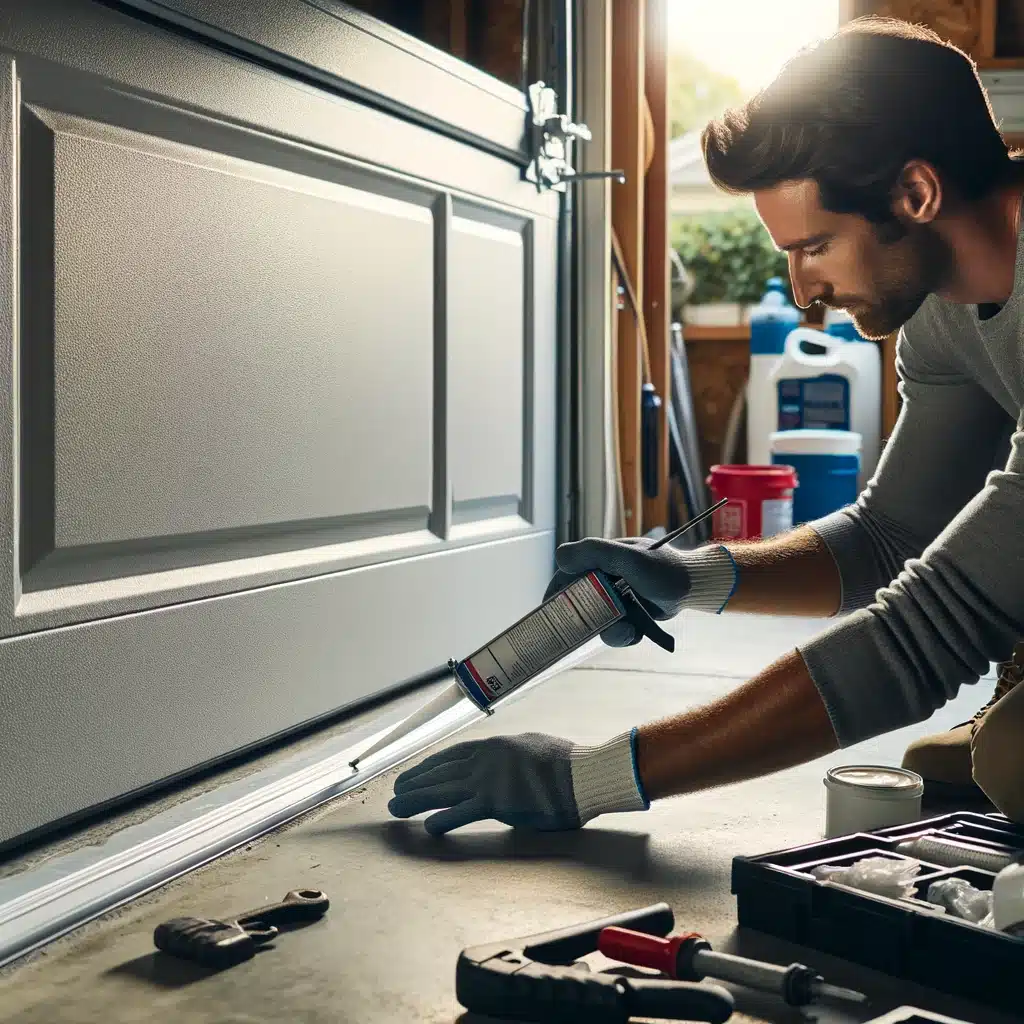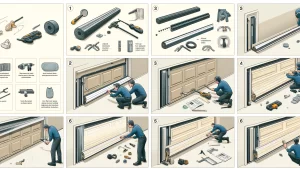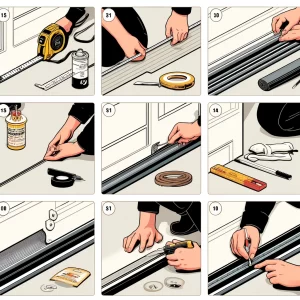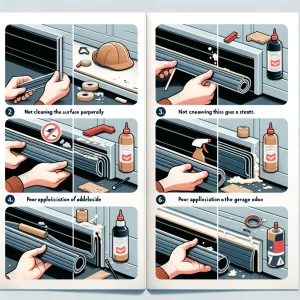You drive up to your house and press the button to open your garage door, only to be met with a blast of freezing air. Once a sanctuary from the elements, your garage now feels like a wind tunnel. But before you call an expensive garage door repair company, know you can likely fix any drafts yourself. You can properly seal your garage door against the cold with a few inexpensive supplies and a Saturday afternoon.
This guide will walk you through a step-by-step process to insulate your garage door using basic materials. Follow our tips to seal out drafts and save hundreds on heating and cooling costs. With a small investment of time, you can make your garage comfortable again.
Why You Should Seal Your Garage Door
Protecting your home’s largest opening is imperative to energy efficiency and security. Sealing and weatherstripping your garage door prevents outside air from entering your garage and home, which can improve the temperature regulation in your living space.
Reduce Energy Bills
An unsealed garage door can allow air infiltration, causing your HVAC system to work harder to maintain the temperature in your home. By sealing and insulating your garage door, you can improve your home’s energy efficiency and reduce utility bills. Weatherstripping and sealing products create an effective barrier against outside air, keeping the conditioned air in your home.
Enhance Security
An unsealed or damaged garage door poses a security risk to your home. Gaps and cracks around the door can provide easy access for pests and in some cases intruders. Sealing and reinforcing your garage door helps prevent unwanted entry into your garage and home. Using a quality sealant or weatherstripping product around the edges of the door, as well as a strong lock or deadbolt, can help boost the security of your garage.
Protect Against Pests
Unsealed openings in and around your garage door provide easy access for pests like rodents, insects, and spiders. Sealing any cracks or holes in the door with a sealant or weatherstripping helps block these unwanted guests from entering your garage and home. A sealed garage door and occasional pest control treatments create an effective barrier against infestations.
In summary, sealing and weatherstripping your garage door is a worthwhile investment that can provide energy efficiency, enhanced security, and pest protection for your home. With various affordable products and DIY methods available, you can easily complete this project yourself or call a professional for help. Improving the seal on your garage door is a great way to save money, boost comfort, and give you peace of mind.
What You’ll Need to Seal a Garage Door
You will require several essential supplies to seal and weatherproof your garage door properly. The most important items are a high-quality exterior caulk or sealant, matching caulk for your garage door’s material, a caulk gun, and paint or primer (if needed). You may also require additional cleaning and protective equipment depending on the current state of your garage door.
High-Quality Sealant
Choose a sealant specifically designed for exterior use and for sealing around doors and windows. For most garage doors, a siliconized acrylic or polyurethane sealant works well. Ensure the sealant is compatible with your garage door’s material, such as wood, metal, or vinyl. For wooden doors, a water-based acrylic latex caulk is a good option.
Caulk Gun
A caulk gun allows you to neatly and efficiently apply the sealant. You can find caulk guns at most hardware stores for around $10 to $15.
Paint or Primer (Optional)
If your garage door is wood or metal and shows signs of damage or rust, it is a good idea to clean, sand, prime, and paint it before applying the new sealant. This will help the sealant adhere better and provide maximum protection.
Cleaning Supplies (Optional)
Have rags, solvents like denatured alcohol, and abrasives like fine-grit sandpaper on hand to properly clean and prepare your garage door’s surface before sealing and caulking. Remove any old caulk or sealant remnants and wipe away dirt or debris.
With the proper tools and supplies, you will be ready to seal, weatherproof, and protect your garage door. Taking the time to do so can help reduce heating and cooling costs and prevent costly repairs.
Step-by-Step Guide to Sealing a Garage Door
Gather the Necessary Supplies
To properly seal and weatherize your garage door, you will need several supplies:
- Garage door seal or weatherstripping: Choose a seal designed for garage doors. The most common types are vinyl, rubber, or foam.
- Measuring tape: Use a tape measure to determine your desired seal size. Measure the width and height of your garage door opening.
- Utility knife: You may need a utility knife to cut the seal to size. Be very careful when using sharp tools.
- Ladder: To reach higher areas, place a ladder next to your garage door. Make sure the ladder is on even ground and lean it at a 75-degree angle.
- Caulk or weatherproof sealant (optional): You can apply caulk or sealant in addition to the leading garage door seal for small gaps or seams.
Clean the Garage Door
Clean your garage door thoroughly to remove any dirt or debris. Use a damp cloth to wipe down the entire surface of the door. Allow the door to dry completely before proceeding to the next step.
Install the New Seal
Place the seal against the edge of the garage door frame where the door meets the frame. Place a seal on each side for doors that close in the center. Press firmly so the seal adheres securely. Use a utility knife to cut the seal to fit around curves or corners.
Apply caulk or sealant over any small gaps for maximum protection. Ensure the caulk is rated for outdoor use. Smooth the caulk with a damp finger before it dries.
Test and Adjust
Once you have installed the new garage door seal, test it properly. Close your garage door and see if any light is visible around the edges. Make any final adjustments to ensure an optimal seal. Your newly weatherized garage door should help improve energy efficiency and withstand the elements. Re-check and reapply or replace the seal every few years to maintain protection.
Common Mistakes to Avoid When Sealing a Garage Door
To successfully seal and weatherize a garage door, it is essential to avoid several common mistakes. Failure to do so can compromise the effectiveness of your efforts and may lead to damage.
Using the Incorrect Sealant
Choosing a sealant not intended for use on garage doors can lead to poor adhesion and durability. Only use sealants specifically designed for sealing and weatherizing garage doors, such as polyurethane or silicone. These provide strong adhesion to the materials used in most garage doors, like wood, vinyl, and metal. They are also flexible enough to withstand the motion of the opening and closing mechanism. Avoid using caulk, as it does not have the necessary adhesion or durability for this application.
Failing to Clean and Rough up the Surface
For the sealant to adhere properly, the surface must be clean, dry, and slightly rough. Wipe down the garage door to remove dirt or debris. Lightly sand any glossy areas to rough up the surface. This provides a tooth for the sealant to grip onto. Wipe away dust with a tack cloth before applying the sealant.
Not Allowing Proper Curing Time
Once the sealant has been applied, do not operate the garage door for at least 24 hours for proper curing. This ensures the sealant has adequately dried and bonded before being subjected to the opening and closing mechanism forces. Operating the door too soon can cause the sealant to fail prematurely.
Improper Application Technique
Apply the sealant in a continuous bead, using a caulk gun. Smooth it with a putty knife or caulk tool, pressing it into gaps or seams. Apply in sections to ensure even coverage, using painter’s tape to mask off areas as needed. Remove the tape before the sealant dries completely. Follow the directions on the product packaging for proper application techniques.
You can successfully seal and weatherize your garage door by avoiding these common mistakes and following best practices. With the proper sealant and technique, you can significantly improve its energy efficiency and lifespan.
Frequently Asked Questions
How do you install a garage sealer?
Clean the garage floor thoroughly. Apply the sealer using a roller or brush, starting from the back of the garage and working towards the entrance. Allow it to dry according to the manufacturer’s instructions before applying a second coat if necessary.
How do you seal gaps around garage doors?
Measure the gaps and cut weather stripping to fit. Attach the weather stripping to the sides and top of the door frame using adhesive, nails, or screws. For the bottom gap, install a rubber or vinyl door sweep.
Should a garage door be completely sealed?
Yes, sealing your garage door completely helps to prevent drafts, pests, and moisture from entering, enhancing energy efficiency and protecting the contents of your garage.
How to make a garage door seal tighter?
Inspect the current weather stripping and replace any worn or damaged sections. Adjust the garage door tracks and ensure the door is properly aligned. Install or replace the bottom door seal and side weather stripping to ensure a snug fit.
How do you attach a rubber seal to a garage door?
Clean the bottom of the garage door. Measure and cut the rubber seal to the correct length. Apply adhesive to the seal or use screws to attach it to the bottom edge of the door, ensuring it fits tightly to prevent any gaps.
Conclusion
Sealing your garage door doesn’t have to be a daunting task. With the proper guidance and effort, you can transform your drafty garage into a well-insulated space, saving you money on energy bills and enhancing your home’s comfort.
At Perfect Solutions Garage Door, we empower homeowners to take control of their garage maintenance. However, if you prefer professional assistance or want to ensure the job is done perfectly, our team is here to help. Our experts are equipped to provide top-notch service, ensuring your garage door is sealed to perfection.
Don’t let drafts compromise your comfort and increase your energy costs. Contact Perfect Solutions Garage Door for an expert garage door repair and let us help you achieve a perfectly sealed garage. Your satisfaction is our top priority, and we’re dedicated to providing solutions that make a difference. Reach out to us now and experience the quality and care that set us apart!
End Note
At Perfect Solutions Garage Door, we are passionate about delivering exceptional garage door services that cater to all your needs. Our expert team is here to provide professional installation, reliable maintenance, and prompt repairs, ensuring your garage door operates smoothly and efficiently.
Dive into our comprehensive range of services and see the quality of our work by visiting our Garage Door Services and Gallery pages. We proudly serve various locations, bringing top-tier services directly to your community. Check our Service Areas to see if we operate in your neighborhood.
Discover our mission, values, and unwavering dedication to customer satisfaction on our About Us page. Stay informed with the latest tips, trends, and insights on garage door repair and maintenance by following our Blog. Connect with us on Facebook for real-time updates, customer reviews, and engaging content.
We are here to provide the perfect solution for your garage door needs. Don’t wait—reach out through our Contact Us page today. At Perfect Solutions Garage Door, your satisfaction is our top priority. Contact us now and experience the difference.





